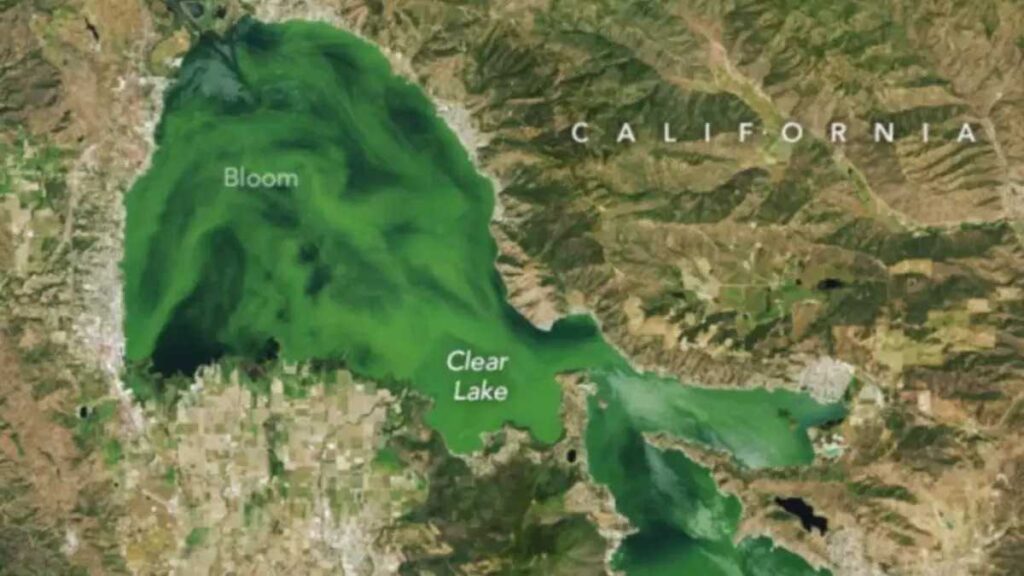What started as a regular day with the National Aeronautics and Space Administration (NASA) capturing images of California’s largest lake quickly became a very unexpected but unique discovery.
Clear Lake had a very noticeable change that could be seen all the way for space that aroused concern from the experts involved.
An Unusual Discovery
NASA officials were carrying out a routine mission using their Landsat 9 satellite to take images of Clear Lake when they noticed a very surprising discovery. All the way from space, the scientists noticed that Clear Lake appeared very bright green, which was quite unusual.
However, experts have attributed this change in color to an algae bloom, which may cause a lot of damage to the wildlife in the water very soon.
People Use the Lake for Several Purposes
Not only is Clear Lake the largest of its kind in California, but it is also one of the oldest lakes in the state. It lies just 60 miles north of the San Francisco Bay, and residents use it for swimming, boating, and fishing.
However, this sudden increase in algae in the water will put a pause on these activities for a couple of weeks because the algae is dangerous to humans.
The Wildlife Systems
The lake is one of the oldest and most important wildlife habitats in California. It is about 500,000 years old and an important source of support for the wildlife systems in the area. There are large populations of fish and birds, like ducks, pelicans, and bald eagles, which depend on this waterbody for survival.
However, the increase in algae has caused some of the fish to die and pose a threat to others.
WATCH: Wolves Thrive in Chernobyl’s Radioactive Land, Develop Unexpected Abilities
The Animals Cannot Breathe Properly
Algae are dangerous to this wildlife system because of the toxins they produce. They also use up a lot of oxygen in the water, thereby reducing the availability of wildlife in the water.
Therefore, the animals will be unable to breathe and begin to die while the algae thrives and pollutes the body of water even further.
The Blooming Algae
This blue-green algae, which is also known as Cyanobacteria has been recurring in Clear Lake for a long time. However, the last century has shown a huge surge in their population due to human activity and environmental changes.
It comes from vineyards, gravel mines, runoff from darks, and even faulty septic tanks, thereby increasing the algae population in the lake.
The Earliest Bloom in History
Throughout the history of the lake, algae blooms during the summer months. This is because this algae typically needs warm weather to thrive. However, this recent bloom happened just before summer started, and it is the earliest time that this has ever happened at Clear Lake.
Therefore, this bloom is most likely thanks to the current declining climate and environmental conditions.
Algae Can Be Toxic
Once they were notified about the algae bloom, officials in California quickly put out a ban on all activities at the lake until the government fixed this problem. This is because the algae is highly toxic to humans.
Many species of Cyanobacteria release some toxins that can cause serious damage to the liver or cause allergic reactions such as headaches, wheezing, coughing, and irritation of the eyes or skin.
POLL—Is Climate Change a Major Threat That Requires Immediate Policy Action?
The Cost Implications of the Bloom
This algae bloom affects the health of citizens and the national economy. Every year, the country spends more than $50 million trying to deal with the problem. This huge amount of money covers health costs, recreation, tourism, monitoring, and health-related issues.
With more than 1,200 lakes experiencing unprecedented algae blooms, officials expect the cost to increase significantly in the years to come.
Carrying Out Tests
For a decade, the Big Valley Band of Pomo Indians has been in charge of testing the water. Therefore, they know the time of the patterns and changes that Clear Lake undergoes and also the time for algae blooming.
However, the testing this year has shown that not only is this the earliest bloom that the lake has ever experienced, but it is also the worst case of algae bloom that has ever been recorded.
WATCH: More Bad News for California Residents Amid New Minimum Wage Hike
A Rapid Growth Rate
On May 8th, they tested Clear Lake for toxicity, and there was no indication of an algae bloom. However, just a week after the test, NASA’s imaging showed a huge difference, with the water completely turning green.
Therefore, scientists compared the results of Imagine at the same time in 2023, which was completely clear, to the bright green image from 2024 and saw that the difference was quite significant.
Using Many Professional Tools
To further understand the huge change, the scientist carried out many tests on the water from the lake using a water quality analysis tool. The results showed high levels of Cyanobacteria, chlorophyll-a, and phytoplankton concentrations that started to increase throughout the early days of May using Sentinel-3, an ocean color tool.
The NOAA National Ocean Service also carried out tests that had similar results.
More Tests Will Determine Treatment
Since the tests did not only find algae in the water, scientists have to confirm the exact types of bacteria in the lake. Once they get the results, they can begin to determine the exact treatment routine to carry out to make the lake safe again for the wildlife living in it and humans around.
Hopefully, the treatment will also prevent future problems at the lake.
You Might Also Like:
Customers Fume as Self-Checkout Machines Request for Tip
US Government Files Lawsuit Against Adobe Over Hidden Fees and Subscriptions
Hillary Clinton’s D-Day Comments Sparks Outrage
“Big Bang Theory” Fans Congratulate Kaley Cuoco for Career Milestone
Kentucky Farmer Discovers Coins Worth Millions in a Field
